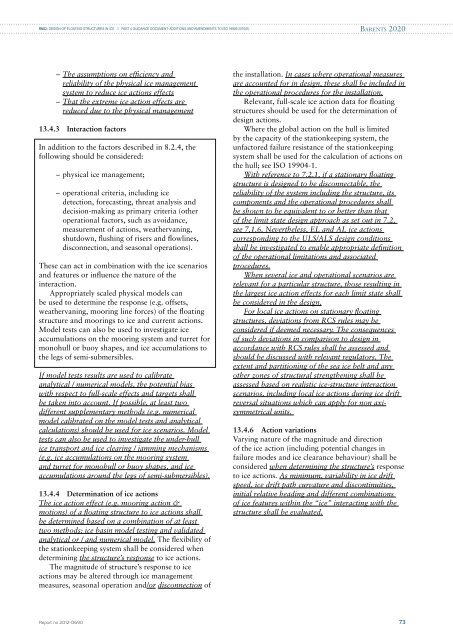phase 4 report - DNV
phase 4 report - DNV
phase 4 report - DNV
Create successful ePaper yourself
Turn your PDF publications into a flip-book with our unique Google optimized e-Paper software.
RN02: DESIGN OF FLOATING STRUCTURES IN ICE // PART 4 Guidance Document: Additions and Amendments to ISO 19906:2010(E)Barents 2020––The assumptions on efficiency andreliability of the physical ice managementsystem to reduce ice actions effects––That the extreme ice action effects arereduced due to the physical management13.4.3 Interaction factorsIn addition to the factors described in 8.2.4, thefollowing should be considered:––physical ice management;––operational criteria, including icedetection, forecasting, threat analysis anddecision-making as primary criteria (otheroperational factors, such as avoidance,measurement of actions, weathervaning,shutdown, flushing of risers and flowlines,disconnection, and seasonal operations).These can act in combination with the ice scenariosand features or influence the nature of theinteraction.Appropriately scaled physical models canbe used to determine the response (e.g. offsets,weathervaning, mooring line forces) of the floatingstructure and moorings to ice and current actions.Model tests can also be used to investigate iceaccumulations on the mooring system and turret formonohull or buoy shapes, and ice accumulations tothe legs of semi-submersibles.If model tests results are used to calibrateanalytical / numerical models, the potential biaswith respect to full-scale effects and targets shallbe taken into account. If possible, at least twodifferent supplementary methods (e.g. numericalmodel calibrated on the model tests and analyticalcalculations) should be used for ice scenarios. Modeltests can also be used to investigate the under-hullice transport and ice clearing / jamming mechanisms(e.g. ice accumulations on the mooring systemand turret for monohull or buoy shapes, and iceaccumulations around the legs of semi-submersibles).13.4.4 Determination of ice actionsThe ice action effect (e.g. mooring action &motions) of a floating structure to ice actions shallbe determined based on a combination of at leasttwo methods: ice basin model testing and validatedanalytical or / and numerical model. The flexibility ofthe stationkeeping system shall be considered whendetermining the structure’s response to ice actions.The magnitude of structure’s response to iceactions may be altered through ice managementmeasures, seasonal operation and/or disconnection ofthe installation. In cases where operational measuresare accounted for in design, these shall be included inthe operational procedures for the installation.Relevant, full-scale ice action data for floatingstructures should be used for the determination ofdesign actions.Where the global action on the hull is limitedby the capacity of the stationkeeping system, theunfactored failure resistance of the stationkeepingsystem shall be used for the calculation of actions onthe hull; see ISO 19904-1.With reference to 7.2.1, if a stationary floatingstructure is designed to be disconnectable, thereliability of the system including the structure, itscomponents and the operational procedures shallbe shown to be equivalent to or better than thatof the limit state design approach as set out in 7.2,see 7.1.6. Nevertheless, EL and AL ice actionscorresponding to the ULS/ALS design conditionsshall be investigated to enable appropriate definitionof the operational limitations and associatedprocedures.When several ice and operational scenarios arerelevant for a particular structure, those resulting inthe largest ice action effects for each limit state shallbe considered in the design.For local ice actions on stationary floatingstructures, deviations from RCS rules may beconsidered if deemed necessary. The consequencesof such deviations in comparison to design inaccordance with RCS rules shall be assessed andshould be discussed with relevant regulators. Theextent and partitioning of the sea ice belt and anyother zones of structural strengthening shall beassessed based on realistic ice-structure interactionscenarios, including local ice actions during ice driftreversal situations which can apply for non axisymmetricalunits.13.4.6 Action variationsVarying nature of the magnitude and directionof the ice action (including potential changes infailure modes and ice clearance behaviour) shall beconsidered when determining the structure’s responseto ice actions. As minimum, variability in ice driftspeed, ice drift path curvature and discontinuities,initial relative heading and different combinationsof ice features within the “ice” interacting with thestructure shall be evaluated.Report no 2012-0690 73






![Risk Based Pipeline Integrity Management [Compatibility Mode] - DNV](https://img.yumpu.com/50424229/1/190x146/risk-based-pipeline-integrity-management-compatibility-mode-dnv.jpg?quality=85)









